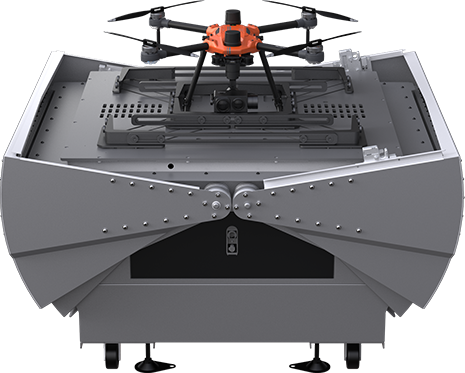

STATION

CUNA2
Used by placing it continuously in one location as a fixed station. Since the drone is left on inside the station, unnecessary time for flight settings, etc., can be reduced.
24/7 System
The drone can be stored 365 days a year, 24 hours a day, regardless of temperature or season.
-
 Waterproof Rating
Waterproof Rating
IP53 -
 Heating and cooling
Heating and cooling -
 Year-round operation
Year-round operation
storage
Automatic Landing and Charging System
It automatically takes off and lands, and upon completing a mission and landing, it undergoes automatic recharging.
-
 Automatic Unmanned Operation
Automatic Unmanned Operation -
 Automatic Landing
Automatic Landing -
 Automatic Charging
Automatic Charging
Scenario using Drone In a Box
-
Basic Mission-Return-Charging Scenario

-
ConceptIf there is only one station, its operation is simple.
When the drone's battery is fully charged, the drone flies up and performs its mission.
After completing the mission, it returns to the station and gets ready to be charged again. -
Pros & ConsPros: Simple Structure, Easy to Operate
Cons: Not continuous operation.
-
-
Alternating Mission-Return-Charging Scenario

-
ConceptAssume there are more than one station with the same number of drones.
With this topology, one drone can do a mission while other drones being charged and ready for flight.
This scheme will reduce the time for preparing another flight. -
Pros & ConsPros: the continuity of service improves. The rest time between flights is shortened.
Cons: when the charging time increases in one of drones, the overall efficiency becomes bad.
-
-
Sequential Hopping System

-
ConceptAssume there are more than one station with only one drone.
A drone can land at any station when its battery is almost done.
When each station is properly located around the target area,
only one drone can cover wide area. -
Pros & ConsPros: the coverage becomes wider.
Cons: cost for additional stations.
-
-
Push-Pull Scenario

-
ConceptAssume there are more than one station with the same number of drones.
When all drones are charged, they can be rotated among stations.
For example, there are three stations (A, B, C) and three drones (1, 2, 3).
Initially, Drone 1 is at Station A, Drone 2 is at Station B, and Drone 3 is at Station C.
When the mission starts, Drone 1 moves to Station B, Drone 2 moves to Station C,
and Drone 3 moves to Station A simultaneously.
This routine can be kept going in a continuous loop. -
Pros & ConsPros: the coverage is wider, and the system can monitor wider area simultaneously.
Cons: cost for additional stations and drones.
-
Anywhere on Earth
as long as there is internet connectivity for operation via the argosALES operating software, it can be operated by administrators.
